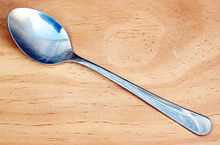Dessert spoon

A dessert spoon is a spoon designed specifically for eating dessert and sometimes used for soup or cereals. Similar in size to a soup spoon (intermediate between a teaspoon and a tablespoon) but with an oval rather than round bowl, it typically has a capacity around twice that of a teaspoon.
The use of dessert spoons around the world varies greatly; in some areas, they are very common while in other places the use of the dessert spoon is almost unheard of—with diners using forks or teaspoons for their desserts instead.[1]
In most traditional table settings, the dessert spoon is placed above the plate or bowl, separated from the rest of the cutlery, or it may be brought in with the dessert.[2]
As a unit of culinary measure, a level dessertspoon (dstspn.) equals two teaspoons, or 10 milliliters, whereas a tablespoon is three teaspoons, 15 milliliters or one half ounce. In Australia a tablespoon is two dessertspoons, or 20 milliliters, which is the old British standard. For dry ingredients, a rounded or heaped teaspoonful is often specified instead.
As a unit of Apothecary measure, the dessert-spoon was an unofficial but widely used unit of fluid measure equal to two fluid drams, or 1⁄4 fluid ounce.[3] In the USA and pre-1824 England, the fluid ounce was 1⁄128 of a Queen Anne wine gallon (which was defined as exactly 231 cubic inches) thus making the dessert-spoon approximately 7.39 cc. The post-1824 (British) imperial Apothecaries' dessert-spoon was also 1⁄4 fluid ounce, but the ounce in question was 1⁄160 of an imperial gallon, which was originally defined as 277.274 cubic inches, but later adjusted to approximately 277.419433 cubic inches, in either case yielding a dessert-spoon of approximately 7.10 cc.[4]
In both the British and American variants of the Apothecaries' system, two tea-spoons make a dessert-spoon, while two dessert-spoons make a table-spoon. In pharmaceutical Latin, the Apothecaries' dessert-spoon is known as cochleare medium, abbreviated as cochl. med. or less frequently coch. med., as opposed to the tea-spoon (cochleare minus or minimum) and table-spoon (cochelare magis or magnum).[5]
Sources
- ↑ Martin, Judith (March 13, 2005). "On the Offensive". The Washington Post.
- ↑ "The Secret of the Formal Place Setting". Diner's Digest. CyberPalate LLC. 1997.
- ↑ Sir Robert Christison (1842). A dispensatory, or commentary on the pharmacopoeias of Great Britain: comprising the natural history, description, chemistry, pharmacy, actions, uses, and doses of the articles of the materia medica. Black. p. 38. Retrieved 20 December 2011.
- ↑ Robert Borneman Ludy (1907). Answers to questions prescribed by pharmaceutical state boards. J.J. McVey. p. 125. Retrieved 20 December 2011.
- ↑ Robert Gray Mayne (1881). A medical vocabulary; or, An explanation of all names, synonymes, terms, and phrases used in medicine. p. 91. Retrieved 20 December 2011.
External links
| Wikimedia Commons has media related to Dessert spoons. |
- Silver place settings, from Butler's Guild